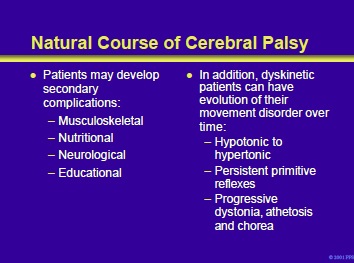Page 11 of 11

Patients with the pyramidal type of cerebral palsy and spasticity can develop a number of secondary complications including:
- Musculoskeletal (eg, contractures, scoliosis, weakness from inactivity and learned non-use)
- Nutritional problems (eg, feeding difficulties, gastroesophageal reflux)
- Neurological problems (eg, spasticity, incontinence, seating and positioning)
- Educational problems (eg, primary learning disorders or impaired cognition and impaired communication)
In addition, dyskinetic patients may show an evolution of their disorder with time:
- May evolve from hypotonic to hypertonic • May maintain primitive reflexes (to their movement disorder)
- Can show progressive dystonic, athetosis and chorea
- Go to Next section Management of spasticity in cerebral palsy Part II Passive and Active Examination
Add comment